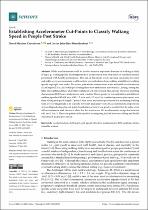| dc.contributor.author | Conradsson, David Moulaee | |
| dc.contributor.author | Bezuidenhout, Lucian John-Ross | |
| dc.date.accessioned | 2022-07-14T09:14:11Z | |
| dc.date.available | 2022-07-14T09:14:11Z | |
| dc.date.issued | 2022 | |
| dc.identifier.citation | Conradsson, D. M., & Bezuidenhout, L. J. R. (2022). Establishing accelerometer cut-points to classify walking speed in people post stroke. Sensors , 22(11), 4080. https://doi.org/10.3390/s22114080 | en_US |
| dc.identifier.issn | 1424-8220 | |
| dc.identifier.uri | https://doi.org/10.3390/s22114080 | |
| dc.identifier.uri | http://hdl.handle.net/10566/7594 | |
| dc.description.abstract | While accelerometers could be used to monitor important domains of walking in daily
living (e.g., walking speed), the interpretation of accelerometer data often relies on validation studies
performed with healthy participants. The aim of this study was to develop cut-points for waistand ankle-worn accelerometers to differentiate non-ambulation from walking and different walking
speeds in people post stroke. Forty-two post-stroke persons wore waist and ankle accelerometers
(ActiGraph GT3x+, AG) while performing three non-ambulation activities (i.e., sitting, setting the
table and washing dishes) and while walking in self-selected and brisk speeds. Receiver operating
characteristic (ROC) curve analysis was used to define AG cut-points for non-ambulation and different
walking speeds (0.41–0.8 m/s, 0.81–1.2 m/s and >1.2 m/s) by considering sensor placement, axis,
filter setting and epoch length. Optimal data input and sensor placements for measuring walking
were a vector magnitude at 15 s epochs for waist- and ankle-worn AG accelerometers, respectively. | en_US |
| dc.language.iso | en | en_US |
| dc.publisher | MDPI | en_US |
| dc.subject | Stroke | en_US |
| dc.subject | Mortality | en_US |
| dc.subject | Health science | en_US |
| dc.subject | Accelerometers | en_US |
| dc.title | Establishing accelerometer cut-points to classify walking speed in people post stroke | en_US |
| dc.type | Article | en_US |

